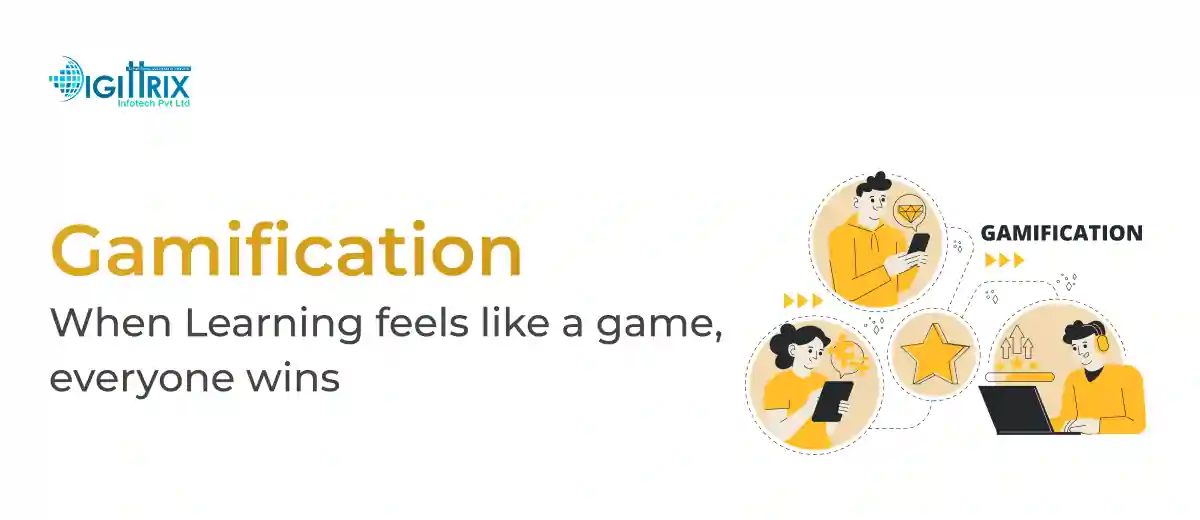Adding game features to learning helps students stay interested, remember better, and finish lessons more often across many apps and platforms.
Highlights
With Over 14 years of Experience in the IT Field, Helping Companies Optimise there Products for more Conversions

Learning can sometimes feel like a chore, but adding game elements can turn study time into play time. This approach is called gamification, and it involves taking parts of games—such as scoring systems, progress levels, badges, and challenges, and putting them into educational settings. The result? Students are more eager to participate, keep going longer, and remember what they’re studying.
In this article, we’ll walk through why gamification works, show real examples, and give practical advice for using it in classrooms, online courses, and apps.
Looking to build an educational platform? Explore how eLearning app development empowers startups and EdTech companies to succeed.
In games, earning points or unlocking levels brings a sense of achievement. When these elements are incorporated into lessons, students experience a feeling of completion and success. For example, answering quiz questions might earn “stars” or advance players on a level board. These small victories help keep motivation high.
Games display your progress, like progress bars or “level 3 unlocked.” Similarly, in gamified education, students can see how far they’ve come and what’s ahead. This feedback loop keeps them focused and helps them plan what to do next.
Leaderboards or class rankings introduce social elements into learning. Friendly rivalry motivates students to put in a bit more effort. And it’s not just about competition—many systems recognise when someone helps others or achieves personal bests.
Games often include surprise elements like bonus rounds or secret rewards. In learning tools, unexpected challenges or bonus content can keep the experience fresh and exciting, even when the topic is tough or repetitive.
Our brains release pleasure chemicals when we hit a goal or get praise. Gamification offers small, ongoing rewards—like badges or praise messages—that keep students motivated and happier while studying.
Watching a video or reading text is passive. Gamified lessons, by contrast, ask students to answer questions, beat time limits, or complete quests. This participation strengthens memory and helps create lasting impressions.
In games, failing a level isn’t the end—you can try again. Gamified platforms often allow retries so students feel comfortable experimenting. They learn better when mistakes are part of the process, not punished.
If students feel stuck or bored, they often give up. Gamification’s frequent small victories keep studying engaging. Students remain motivated and focussed for longer because the pace feels quicker and more enjoyable.
Here are some well-known features that make educational content feel like play:
Teachers use gamified apps or platforms at school to enhance classroom engagement. For instance, a maths app might award badges for solving problems or keep a weekly leaderboard to foster interest and peer support.
Massive open online courses (MOOCs) like Coursera or Udemy include gamification techniques such as issuing certificates, quizzes with points, or digital badges. This approach boosts completion rates and student engagement.
Businesses use gamified training platforms to make mandatory training more enjoyable for staff. Completing modules might earn them extra days off or team recognition, increasing participation and skill growth.
Test prep apps often include game features: daily challenges, streaks for ongoing use, and quizzes with timer modes. This makes practice more engaging and less stressful.
If you want to create your education mobile app or course with gamification, follow this step-by-step process:
Understand who your learners are—their age, preferences, strengths, and where they tend to struggle. A children’s cooking quiz might feature bright visuals and playful avatars, while adult learners might prefer progress stats or knowledge checks.
Decide what you want students to achieve. It could be mastering multiplication tables, improving reading speed, or passing a professional exam. Create game elements that match these goals.
Choose elements that suit the target and age group. Younger students might enjoy colourful badges, while adult learners could prefer streak tracking or peer rankings. Avoid overloading the experience with too many elements, as it might distract them from learning.
Break content into manageable chunks and plan the progression. For example, ten levels, each with multiple questions, where each correct answer earns a badge and points towards unlocking the next level.
Make sure students find out immediately if they’re correct and why. Visual cues, like green ticks or red X's, help reinforce learning. Rewards like virtual stickers or congratulatory messages can keep morale high.
Design units to be replayable. For example, quiz modes with randomised questions allow students to build mastery. Streak counters (days in a row studied) help sustain consistent study habits.
Gather data on which levels present difficulties and where learners are most engaged. Use this information to refine questions, pacing, or rewards. This leads to a better experience over time.
Enable users to share badges or scores with friends or classmates. Allow them to suggest tasks, congratulate peers, or ask questions. Social features often enhance motivation to keep improving.
Many educational tools, apps, and services now feature gamification. Companies developing educational apps focus on designing applications with quizzes, challenges, and reward systems integrated to keep content engaging.
A company that develops apps specialising in learning platforms can support schools or organisations in creating engaging digital products. They design the interface, write the code for features, and incorporate game-like elements aligned with educational objectives.
With the growth of mobile app development, learners can study anywhere—on the bus, at the park, or while waiting in line. Mobile-friendly design makes it easy to complete short quizzes or review flashcards during spare moments.
Additionally, some businesses provide on-demand app development services. That means you can request a customised solution—like a gamified language practice tool—and the team will develop it quickly, using proven game mechanics to make the app enjoyable and user-friendly.
Even learners who often feel intimidated by new topics can feel more secure in a game-like environment that provides second chances and small victories.
Some learners might chase badges rather than genuinely grasp the material. Tackle this by tying rewards to tasks that require real thinking—for instance, accurately explaining a concept instead of just clicking quickly.
When the novelty wears off, interest might fade. Keep content updated: add new levels, extra challenges, or group activities so the app always feels fresh.
Giving content that doesn’t match learners’ abilities can be off-putting. Use pre-tests or let users choose their starting level. Monitor quiz results and adapt difficulty dynamically.
Practice should connect to real-world tasks. An app for math might include story problems about budgeting or time. Language apps can include role-play simulating ordering at a cafe.
To check if gamification is helping:
Combine these metrics to figure out what works and where improvements are needed.
Gamification is growing. Expect more use of:
As the demand for apps developed by mobile app development teams grows, more learning platforms will become available. Whether schools, businesses, or individuals seek help, the path to better digital learning is led by smart education app development companies.
Thinking about building an app for schools? Check out this in-depth guide to school mobile app development in 2025, covering must‑have features, benefits, and development steps.
Gamification turns studying into play by adding goals, progress feedback, rewards, challenges, and surprises. It taps into motivational psychology, boosts engagement, and suits many learning styles. While there are some design challenges, careful planning, feedback collection, and upkeep help keep content fresh and meaningful.
If you’re a teacher, parent, trainer, or entrepreneur, you can begin with simple quizzes and badges. For larger projects, consider hiring an app development company. With modern app design tools and on-demand app services, you can develop an engaging, interactive learning platform quicker than you might expect.
Gamification is transforming how students engage with learning tools, and selecting the right app makes all the difference. Whether you’re planning to launch a learning app for schools, build a language training platform, or offer employee upskilling solutions, choosing the right development approach is essential.
At Digittrix, we help businesses and educators turn their ideas into fully functional digital products. With over 14 years of experience in mobile app development, our team creates customised learning platforms with gamification. Whether you’re starting from scratch or looking to launch quickly with pre-built features, we offer options that suit your content, users, and budget.
Need help choosing between custom or on-demand app development for your learning idea? Contact our team—our experts are here to assist you in making the right decision. Call us at +91 8727000867 or email digittrix@gmail.com to book a free consultation.

Do you need help in Mobile App development?




Join over 1500+ businesses we've already helped!
Beauty App Development: Tips to Grow Your Business Through an App & Cost in India (2026)
Gamification in education means using game-like features—such as points, levels, and badges—to make lessons more interactive and interesting for students.
It helps by increasing interest, offering rewards, giving instant feedback, and making lessons feel more like a game, which keeps learners focused longer.
Yes, many education apps use gamification. With modern mobile app development, developers can include badges, quizzes, streaks, and rewards to keep users motivated.
No. Adults also benefit from gamified learning, especially in job training or online courses. Game features work for all ages when applied correctly.

©2026Digittrix Infotech Private Limited , All rights reserved.